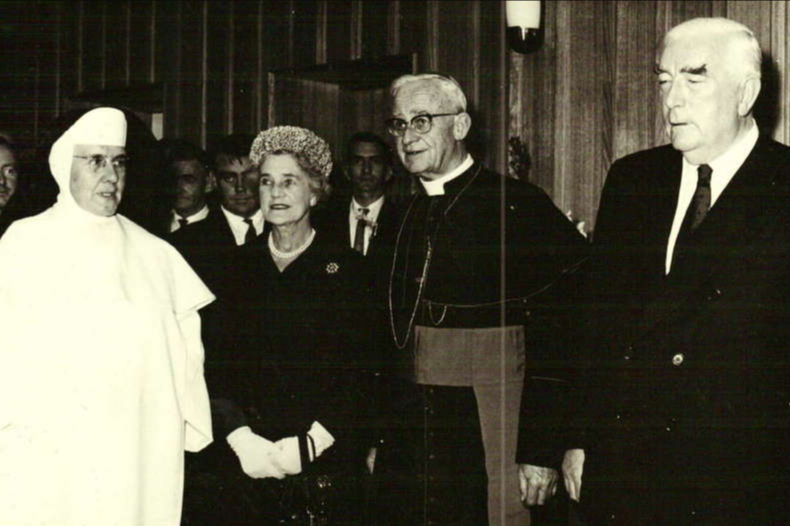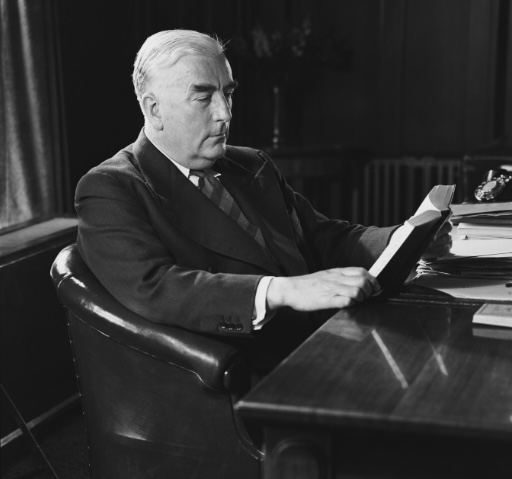On this day, 16 July 1962, up to 2,000 students from six Goulburn-area Catholic schools present themselves to nearby government schools for enrolment, overwhelming the public school system. The Catholic schools had closed the previous Friday on the authorisation of Eris O’Brien, Archbishop of the Canberra-Goulburn Archdiocese, who had called the ‘strike’ in response to the New South Wales Government ordering St Brigid’s Primary School to build a new block of toilets that it simply could not afford. The purpose of the strike was to highlight that the Catholic schools needed some government funding to survive, while demonstrating that if their students were unable to attend Catholic schooling it would cost the public system and the taxpayer far more to cover the whole cost of their education.
This was a watershed moment in Australian political history, acting as a catalyst for the adoption of ‘State Aid’ for independent schools, an innovation in the Australian education system which has endured to this day. ‘State Aid’ would help to break down sectarian divisions that had long endured in Australian society – the poverty of the Catholic schools had contributed to the ‘otherness’ of a large minority group, while the Catholics themselves had long resented paying taxes for an education system which did not service them.
In 1977 Labor speechwriter and historian Graham Freudenberg observed that ‘the oldest, deepest, most poisonous debate in Australia has been about government aid to church schools’. The issue dated back to the 19th century, when colonial governments introduced comprehensive systems of ‘free, compulsory and secular’ education, replacing an older system of schooling that had been based on the Churches. The Catholics rejected this public system because they felt that religious education was an integral part of education, and also that any attempt to teach ‘non-denominational’ Christian ethics via the public schools was thinly veiled Protestantism (in NSW Premier Henry Parkes had not endorsed the ‘secular’ slogan of his Victorian counterparts, and religion was thus to play some role in public schooling).
Apart from Indigenous Australians, Irish Catholics were Australia’s oldest minority group, and their unique education system became a defining aspect of their identity and culture. The fact that they had been able to fund their own schooling through fees and charity, despite often being a relatively impoverished group, was a matter of considerable pride. However, with the growth of science classes and an explosion in student numbers (created by the post-war baby and immigration booms), schooling was becoming increasingly expensive, and these funding methods were failing to keep up with the times.
Menzies’s adoption of the ‘State Aid’ issue is sometimes portrayed as an opportunistic attempt to court the Catholic vote after nearly losing the 1961 election, though this motivation is difficult to sustain as the Catholics were a minority and historically there had been far more votes to be won in taking the Protestant side of the sectarian divide. Moreover, a 1943 radio broadcast on ‘The Future of Education’ shows that Menzies expressed support for ‘State Aid’ decades earlier and even presaged the logic of the strike:
‘What, broadly, is to be the future of the Church schools? It is impossible to contemplate that they are going to be abolished by a wave of the hand. It is true that mounting taxation and a possibly difficult economic future will make it extraordinarily difficult for people to send their children to Church schools. But there will be great and proper hostility to their abolition, for they are the answer made by many thousands of people to the purely secular education provided by the State. There are many thousands of people in this country who believe that education divorced from religion not only is incomplete but may actually be dangerous. It is to the eternal credit of these thousands of people that they have been prepared, for the sake of that deeply held conviction, to pay twice – once as taxpayers for the maintenance of the State schools, and the second time as parents for the maintenance of their children at Church schools. My own opinion is that it is unlikely that the Church schools can in the post-war period efficiently survive unless there is some measure of State assistance to them. Such State assistance would naturally involve some change to the structure of these schools, but it need not affect their essential character. After all, if these schools were not maintained by great Church communities the public as a whole would have to provide far more money for State schools and State instruction. In the past this problem has unhappily been somewhat clouded by a belief that some special case was being made out for the Catholic Church schools.
It is unfortunate for any discussion on a matter so important to go off into a merely sectarian dispute. My own belief is that the maintenance of the Church schools, of whatever denomination, is so important – because a religious background for education is so important – that we must all be prepared to come together in the post-war world to devise ways and means of ensuring that those who are content with a purely secular education should be able to get it, while those whom such an education will never satisfy should be able to get the kind of training they want for their children without absolutely bankrupting themselves in the process.’
Historically, non-Labor politics had frequently been associated with militant Protestantism, but Menzies for his part was always a fierce opponent of sectarianism. He had clashed with his parents after appearing on a platform with Catholic Archbishop Mannix in 1928, and later as the Attorney-General of Victoria he resisted attempts by some Protestants to ban a large Catholic procession through the streets of central Melbourne during a Eucharistic Congress. He would describe sectarian strife as ‘the denial of Christianity and not its proof’.
Once Menzies returned to the prime ministership in 1949, it took a while for his views on ‘State Aid’ to be implemented, partly because education was considered a State rather than a Federal responsibility. With the adoption in 1957 of the Murray Report’s recommendations for Australia’s university system Menzies overcame this obstacle, and this paved the way to do something on ‘State Aid’. This started in the Federally run Australian Capital Territory, where on the back of negotiations with Archbishop O’Brien, the Government began subsidising school buildings for independent schools.
In the lead up to the 1963 election, Menzies expressed his support for parental choice in schooling, saying ‘the greater the variety and versatility in education, the better it would be for all’. In Menzies’s policy speech he would announce 10,000 Commonwealth scholarships for secondary students, £5 million per year to supply buildings and facilities for science teaching in secondary schools, and £5 million to assist the States in building and equipping technical schools. The first two commitments were explicitly to cover both public and independent schools, representing the first example of national ‘State Aid’ and an enduring shift in Australia’s education system.
The issue was a political nightmare for his Labor opponents. Their Federal Conference had already ruled out ‘State Aid’ and the party had open wounds from the sectarian controversies that were intimately associated with the Great Labor Split. Catholics had once been far more likely to vote for Labor than non-Labor, but with the creation of the DLP and now the introduction of ‘State Aid’, the support of a large proportion of them was shifting rapidly.
Nevertheless, the issue was bigger than politics. It was about a fundamental freedom to choose, touching on identity, equality, and deeply held beliefs. Many Australians who otherwise had little regard for Robert Menzies felt a sense of gratitude over this issue.
Further Reading:
A.W. Martin, Robert Menzies, A Life Volume 2 1944-1978 (Melbourne University Press, 1999).
John Warhurst, ‘Fifty years since the “Goulburn Strike”: Catholics and education politics’, Journal of the Australian Catholic Historical Society, Volume 33, 2012, pp.72-82.
Michael Hogan, The Catholic Campaign for State Aid: A study of a Pressure Group Campaign in New South Wales and the Australian Capital Territory, 1950-1972 (Sydney: Catholic Theological Faculty, 1978).
Sign up to our newsletter
Sign up for our monthly newsletter to hear the latest news and receive information about upcoming events.


